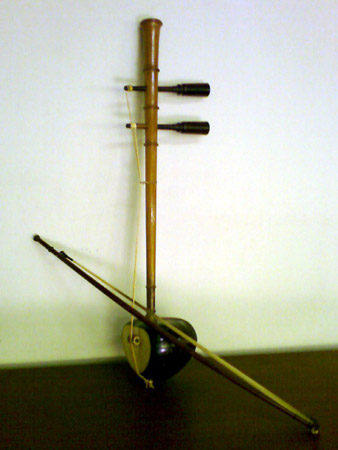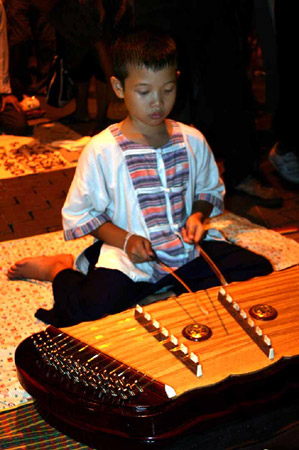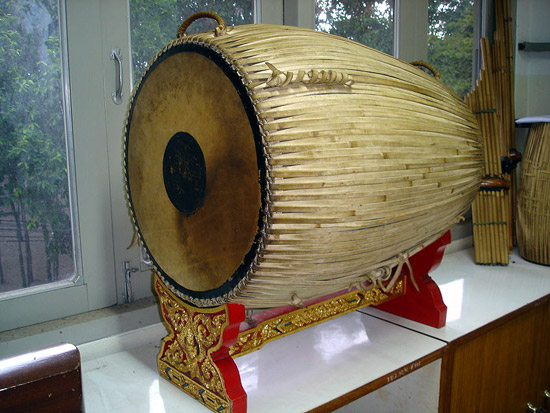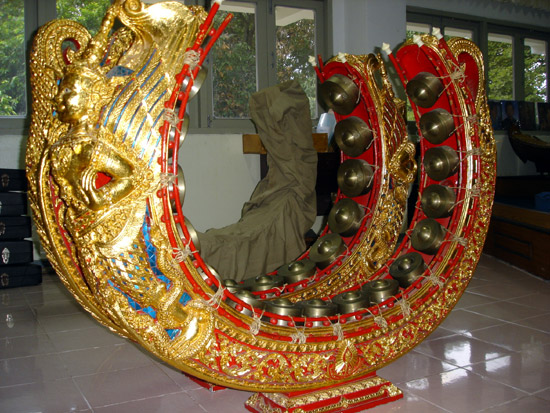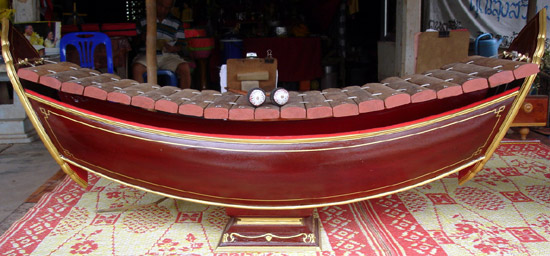Music: Instruments and Ensembles
As in most of Southeast Asia, Thailand also has four traditional categories of instruments: bowed, plucked, percussion, and wind. As seen on fixed-pitch instruments, the Thai system of tuning has tones in the octaves, the octave being divided into each of the 12 Western semitones. In traditional Thai music, the pentatonic scale is the basis of most compositions.
Bowed (Chordophones)
The saw sam sai is a bowed lute with a body made from a type of coconut, covered on the top with an animal-skin membrane. It has three silk strings.
The saw u is the lowest-pitched member of the saw family of bowed instruments. Its two strings are capable of producing notes of a single octave. The soundbox is made from a coconut shell that is covered on the open front by goatskin or calfskin. The saw u is held vertically and has two silk strings that are played with a bow that passes between the strings.
Saw duang is tuned to a higher pitch than the saw u. It has a hardwood soundbox (originally a section of bamboo) covered on the playing end with snakeskin or sometimes goatskin or calfskin. It is also held vertically and has two silk strings that are played with a coarse-haired bow. Like the saw u, the bow is between the strings, so the player must tilt the bow to switch strings.
Plucked (Chordophones)
The krachappi (or grajabpi) is a plucked string instrument with a turtle-shaped sound box made of jackfruit wood or hollowed-out teak. The soundboard has a soundhole (like that of a guitar), often adorned with a rosette pattern. The neck and tuning-peg box are made from one piece of wood and glued to the body. The 13 frets are pieces of white plastic, glued to the flat front of the neck. There are two courses of double nylon strings, which run from the neck to a rather large loose bridge into a tailpiece fixed to the base of the body. Although historically important, this instrument is now rarely in use.
The jakhe is a crocodile-shaped zither made of wood. Its two high strings are made of silk or nylon, and the lowest are made of brass. The instrument has raised frets made of bamboo, which are affixed to the fretboard with wax or glue. The player frets with the left hand on the fretboard and plucks with the right hand using a tapered plectrum made from ivory or water buffalo horn tied to the player’s index finger.
The khim is a hammered dulcimer with a trapezoidal body made of wood, and brass strings stretched across the instrument. There are 14 courses of strings on the khim, with three strings per course. The instrument is played by hammering with two flexible bamboo mallets that are tipped with leather to produce a soft, muted tone. It is used as both a solo and ensemble instrument.
Percussion: Membranophones
The most common drum in Thai folk music is the taphon. This sacred instrument is used in piphat ensembles, in shrines, and as devotional entertainment to gods. The taphon is also known as the sa phon.
The glong thap is a pair of goblet drums used for accompanying the southern Thai nora dance drama. The body is made from jackfruit wood. A single drumhead is covered by a thin leather head made from langur or cat skin, which is attached to the body by rattan strings. The glong thad are almost always played in pairs of a slightly lower-pitched luk thoeng and a slightly higher-pitched luk chap.
The ubiquitous taphon is a fixture in piphat ensembles and is not only a sacred instrument in Thai culture, but the most commonly used drum in Thai folk music. In Thai shrines, Taphon are often used in devotional ceremonies meant to entertain the resident god.
Glong khaek is a double-headed barrel drum. The instrument’s name comes from glong (meaning “drum”) and khaek (meaning “Indian” or “Malay”). There are two types of glong khaek: the higher-pitched glong khaek tua phu, and the lower-pitched glong khaek tua mia. They are always played in a pair, usually by two players, although a single player may play both drums.
The yao, or klong yao, meaning “long drum,” is a single-headed drum that is slung over the shoulder and played by hand. The tapered body, widest at the head, is constructed from hardwood and the drumhead is made from water buffalo skin. A decorative skirt of colorful fabric often adorns the perimeter of the drumhead.
Often used in khruang sai ensembles, the thon and rammana are hand drums used in both Central Thai and Cambodian classical music. The thon is a goblet drum and the rammana is a small frame drum. Played as a pair, the thon produces the lower pitch contrasting the higher pitched rammana.
Percussion: Idiophones
Gongs
Khong wong lek is one of the two forms of gong circle used in piphat. It has 18 tuned gongs, and is smaller and higher in pitch than the khong wong yai. Both instruments are played in the same manner, with the performer seated in the middle of the gong circle, but the khong wong lek player usually adopts a faster and more ornate variation on the principal melody, with less use of two-note double stops.
Providing a supporting melody for the higher pitched Khong wong lek, the Khong wong yai, by contrast, has 16 tuned gongs of slightly lower pitch affixed to a rattan frame. It is used in the piphat ensemble to provide a skeletal melody for the other instruments.
Another type of khong, the khong mon, produces the same range of pitches as its cousins, but is distinguished by a unique horseshoe shape. The two ends of the instrument's wooden frame point upward and feature elaborately carved images painted gold, with one or two rows of gongs running along the inside of the frame. The player sits at the base of the “horseshoe” with the gongs extending overhead on either side.
Cymbals
Small bowl-shaped, broad-rimmed finger cymbals known as ching are used to provide rhythmic accompaniment in several forms of Thai classical music and dance. They are made of thick and heavy bronze—typically an alloy of iron, copper, and gold—and joined together with a cord. Each cymbal of the pair is held in one hand and the two are struck together.
Chap, a thinner version of the ching, is made in two versions: chap lek (small) and chap yai (large).
Xylophones
Ranat is the generic name for Thai-keyed percussion instruments, referring to a variety of xylophones, including the ranat ek and ranat thum used in piphat and mahori ensembles. The bars of the various types of ranat are most often of hardwood; bamboo ranat are not unusual in folk settings, and metal keys (of bronze or iron) have been used in some classical ensembles since the mid-1800s, influenced by Javanese instruments.
Wind (Aerophones)
The most widely used wind instruments in Thai classical music—particularly in piphat, which takes its name from this family of instruments—are the pi double- and quadruple-reed shawms. They have a high, penetrating sound that makes them suitable for muay Thai music as well.
The khlui is an end-blown fipple flute generally made of bamboo, though hardwood and plastic are also used. The instrument occurs in three sizes, with the medium khlui phiang aw the most commonly played.
Article written for World Trade Press by Matthew Monte.
Copyright © 1993—2025 World Trade Press. All rights reserved.

 Thailand
Thailand 